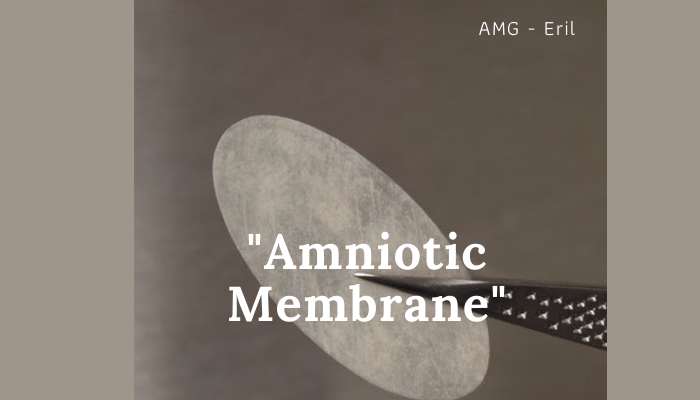Source and definition
Amniotic membrane graft is prepared from amniotic membrane of foetuses. Amniotic membranes are harvested from freshly delivered placentas taken during caesarean section for amniotic membrane allograft.
Use
Amniotic membrane grafts are used to repair the gap in body tissues, cover abdominal organs or raw surfaces during surgery to prevent adhesion formation. Amniotic membrane is also used in ophthalmic surgeries to create a physical barrier to protect conjunctival surface and corneal epithelium.
It has been successfully used to reconstruction of corneal surface (persistent epithelial defects or corneal ulcers, bullous keratopathy, Corneal Perforation, and corneoscleral ulcers etc) and other ophthalmic conditions like neurotrophic Keratitis, Fornix reconstruction, symblepharon, Conjunctival chalasis, Partial Limbal Stem Cell Deficiency, Pterygium Repair, Moderate or Severe Acute Ocular Chemical Burns, and Severe Dry Eye or keratoconjunctivitis secca.
They have also been researched for the use in plastic surgery, spinal surgeries, peripheral neurosurgery, knee osteoarthritis, plantar fasciitis, and urologic surgeries.
Properties
It promotes epithelial cell migration, adhesion between newly formed cells, cell differentiation and inhibition of cell death and prevents angiogenesis. It also has antimicrobial effect and lack histocompatibility antigens so can be used without risk of rejection.
Specially prepared amniotic membranes are safe and effective in dramatically reducing postoperative adhesion formation both in human patients and animal models.
Storage
Canine / Human amniotic membranes can be stored at -80 °C in the glycerol from 8 months to 2 years period. Processed amniotic grafts can be stored up to 5 years. Thickness may vary depending on the graft and use like 35 microns to 100+ microns.
Examples
Ambio5, Ambio dry, aril amniotic membrane, bio d / BioDOptix amniotic membrane, epifix amniotic membrane allograft , prokera amniotic membrane, AmnioGraft
FAQs:
The amniotic membrane is the inner most avascular layer of fetal membranes composed of the epithelium, hypocellular stromal matrix and the thick basement membrane.
It is the innermost fetal layer protecting the foetus during pregnancy.
Amniotic grafts are obtained from placentas collected during elective caesarean sections. Maternal Donors are screened for various diseases like HIV, Hepatitis B etc prior to collection of the fetal membranes.
Commonly used CPT codes for amniotic membrane graft for eye are
CPT Code 65778: Placement of amniotic membrane on the ocular surface; without sutures.
CPT Code 65779: Placement of amniotic membrane on the ocular surface; single layer, sutured.
CPT Code 65780: Ocular surface reconstruction; amniotic membrane transplantation; multiple layers.
* V2790 Amniotic membrane for surgical reconstruction, per procedure
It is a processed layer prepared from foetal amnion or Amniotic membrane.
Amniotic membrane graft (AMG) has excellent healing and anti-inflammatory properties. It can function in the eye as a basement membrane/epithelial membrane substitute or as a temporary graft.
AmnioGraft is an amniotic membrane graft for ocular transplantation in the treatment of corneal ulcers, pterygium, conjunctivochalasis, chemical burns etc.
AMG stands for amniotic membrane graft and AMG eye surgery refers to use of amniotic membrane graft in various ophthalmic surgeries/procedures. Amniotic membrane is very similar in biological and physical properties to the epithelial membrane of eye surface.
